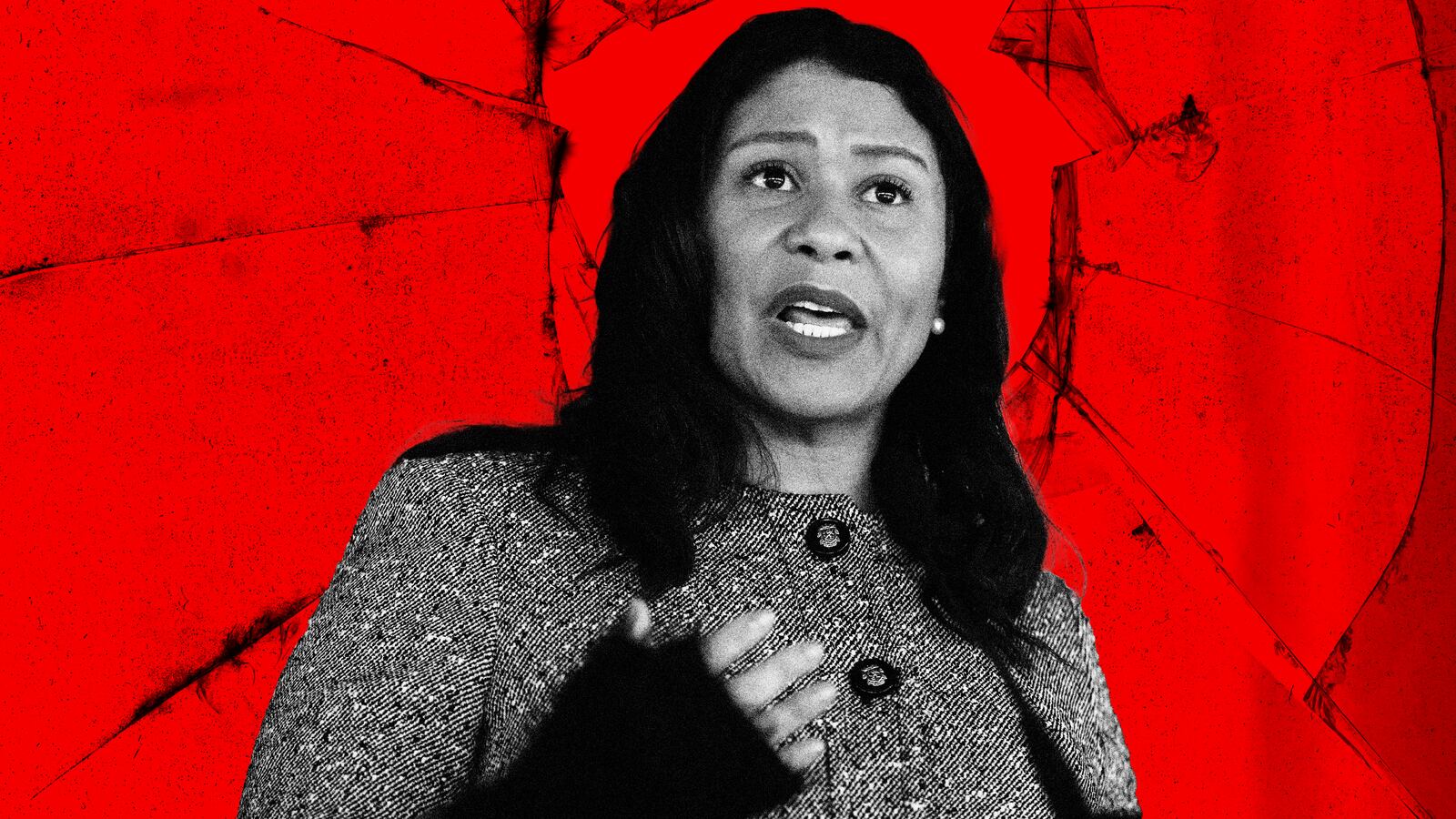SAN FRANCISCO—On Wednesday, San Francisco Mayor London Breed made a fiery speech in response to recent increases in thefts and drug sales and use in the city, particularly in the Tenderloin, a notoriously gritty stretch residents say has had similar issues for decades.
“It’s time that the reign of criminals who are destroying our city, it is time for it to come to an end,” Breed said, arguably sounding more like a police union boss than a Democratic politician in a progressive stronghold. “It comes to an end when we take the steps to be more aggressive with law enforcement. More aggressive with the changes in our policies. And less tolerant of all the bullshit that has destroyed our city.”
The tough talk represented a stark reversal for Breed, who, shortly after the murder of George Floyd last year, stripped $120 million from the San Francisco Police Department to fund initiatives aimed at improving the lives of Black residents. In the days since, her statements have drawn praise from some residents and business owners in the Tenderloin who say they sympathize with justice reform but that longstanding problems have gotten out of control as crime numbers shoot up nationwide.
But they have also drawn ire from detractors who argue Breed risks abandoning a focus on the root causes of crime in a sort of retrenchment that has played out in progressive strongholds across the country since last year’s summer of rage over police violence. Even then, the about face in the liberal bastion of San Francisco is particularly astonishing.
“What’s underneath the surface here is that these local recalls are really impacting our city politics in a way that I think is destructive,” John Hamasaki, a member of the San Francisco Police Commission and criminal defense attorney, told The Daily Beast.
Hamasaki was referring primarily to the upcoming June recall vote of San Francisco District Attorney Chesa Boudin. Boudin, elected in Jan. 2020, had previously served as a public defender in the city and has quickly come under fire for being soft on prosecuting repeat offenders.
Hamasaki also noted viral videos of robberies in the city being shared widely on social media. Given the attention, he said, it seemed Breed was “tacking right.”
“It feels political because it doesn’t address the actual problems,” Hamasaki said.
Breed did not respond to a request for comment. Boudin also did not respond to a request for comment.
During her press conference, Breed pushed back on the idea she was making some kind of “reversal” by demanding more resources for police, among other changes. “I would say that things have changed as it relates to our significant need for law enforcement and so an investment is necessary as a result of it,” Breed said.
Chris Canning, Captain of the Tenderloin Station for the San Francisco Police Department, told The Daily Beast he was “grateful” for the mayor’s call for action. He said that while there have been police-led efforts in the past to address issues in the Tenderloin, what feels different to him is what he called an “all-hands on deck approach for a sustained period of time” that would also involve other city agencies and community organizations.
San Francisco Police Department Chief Bill Scott said during Wednesday’s press conference that there has been a longstanding struggle to balance enforcing laws in the Tenderloin and getting people help. And while he said there will still be an effort to connect people with needed mental-health and substance-abuse services, there is also now a green light to seek enforcement. “People will not be allowed to smoke meth, to smoke fentanyl, to inject heroin in their arms in public spaces,” he said.
But looming behind the relatively unified front—at least this week—between the police department and the mayor were long-standing tensions over justice in a city known both for progressive politics and gilded liberalism.
Tony Montoya, president of the San Francisco Police Officers Association, the local cops’ union, told The Daily Beast Breed’s statements were further proof of the “failed experiment” to defund the police and welcomed her words. “I’m glad the mayor has finally publicly acknowledged that things are, for lack of a better word, out of control,” he said.
While he agreed that there needed to be more police in the Tenderloin, he said the calls for more bodies would have to be backed up by resources. “Unless they’re going to make that financial investment, right now they’re just placating some of the community that are putting pressure on them,” Montoya told The Daily Beast. “At the end of the day, put your money where your mouth is what I say.”
Hamasaki, the local police commissioner, said he was not surprised about the police department’s embrace of Breed, arguing her recent statements were an “early Christmas present” to Montoya and the union, which he accused of overstating problems with crime in the city and the Tenderloin area to call out liberal policies. That is, doing what cop unions tend to do across the country.
“Our crime numbers are lower than a lot of big cities in liberal and conservative districts,” he said. “It’s not a reflection on the government. It’s just a reflection of what’s happening across the nation.”
“This is not fear mongering. This is reality,” Montoya pushed back, in response. He noted that many issues in the area are not new. “But that’s no excuse not to try and find solutions and address it now.”
According to data from the San Francisco Police Department, homicides and thefts have seen rises in recent years in the city across the board—mirroring rises in crime nationwide.
According to the agency’s dashboard, the city has seen a 15 percent year-over-year increase in homicides in 2021 and an 18 percent increase in larceny theft. In the Tenderloin area, homicides are up 13 percent compared to 2020, and burglaries and motor vehicle thefts are up about 7 percent each.
The rise in certain crimes so far this year comes after an already significant city-wide increase in 2020, where homicides were up 17 percent compared to 2019 and burglaries and motor vehicle thefts were up nearly 40 percent compared to 2019.
But what has been more striking, according to city data, is the prevalent drug use and calls for help in the Tenderloin area. According to a recent city report, since Jan. 2020, more than 20 percent of all drug overdose deaths in the city have occurred in the Tenderloin.
According to an emergency declaration released by Breed on Friday, overdose deaths in the city as a whole have increased 200 percent since 2018. In 2020, the number of deaths from drug overdoses in San Francisco exceeded the number of people who died of COVID. The proclamation cited an increase in fentanyl use as a large reason for the deaths. According to the proclamation, the substance was a factor in more than 70 percent of the overdose deaths between January and October.
In the Tenderloin, the proclamation stated that emergency medical calls for service for a “sick person” have increased more than 150 percent between June and November compared to the same period in 2020, and medical calls for service for all reasons during this time period also increased.
On Thursday evening in the Tenderloin neighborhood, a day after Breed’s announcement, the city’s heightened contradictions seemed to be on display.
On one street, tents pitched wall-to-wall crowded both sides of the sidewalk, forcing foot traffic onto the street among strewn trash and debris. In another corner, someone sat slumped on a sidewalk next to an overstuffed suitcase spilling its contents, while someone else appeared to be passed out on the bench in a bus shelter.
Nearby, however, in the windows of restaurants and bars, affluent-looking urban professionals could be seen socializing as if all of this was completely normal.
Those who work in the area every day, like Andrew Bloom, director of operations for Brenda’s Soul Food, a restaurant in the Tenderloin, told The Daily Beast they’ve noticed the neighborhood “nosedive” during the pandemic. Among other things, he cited the widespread selling and consumption of drugs in the street at all times of the day, as well as petty theft and, in some cases, violent incidents.
Bloom acknowledged the area has always struggled with drug use and homelessness in the 11 years he’s worked there. But he called the problem “manageable” in the past, and said that’s changed.
“The whole neighborhood has just been really worse than ever,” he told The Daily Beast.
Bloom described dealers frequently attempting to hawk drugs to him daily, and large numbers of people using hard drugs in doorways, streets, and alleys. “It’s not just like a couple of guys now,” he said. “It’s literally like crowds of people.”
Amanda Michael, owner of Jane on Larkin, a cafe in the area, chalked up the change to the increased sale of fentanyl in the area and a lack of drug enforcement and police presence that became more apparent during the height of the pandemic.
“It was kind of like this perfect storm,” she told The Daily Beast, adding that more tents began popping up in the streets and she could see drug dealers going from tent to tent from her store window. “It was heartbreaking because you just saw this real downhill turn for a lot of people.”
Both Bloom and Michael said they were pleased to hear Breed’s comments this week, but they hoped it would lead to a real change, instead of mere politicking. “I’d like to think it’s real,” Michael said about Breed. Still, she said, she’s worried it might just be “grandstanding.”
Of course, some residents are calling “bullshit” on the mayor, too.
Del Seymour, a longtime resident who leads walking tours in the area and runs a nonprofit to teach coding to many people he says are homeless, said Breed’s talk wasn’t all that stirring to him.
“This is like the fifth mayor to have vowed to clean up the Tenderloin,” he said. “So, I’m not really expecting a lot out of this.”
Seymour, 75, said that until he turned his life around 13 years ago, he spent many years in the Tenderloin homeless, selling and using drugs in the streets there. Given his own history of arrests, he said, he fears the mayor’s new tune won’t help those struggling with substance abuse in the area.
“I really don’t want to see another war on drugs,” he said. “Drug use is a disease, it’s not a crime.”
Seymour said he knows the mayor believes this, and cited her investments in treatment centers and social services in the area in the past. But he said the “publicity event” on Wednesday seemed like an effort to “bow down” to special interests.
During her press conference, Breed acknowledged that the city has always been a “compassionate” one that prides itself on “second chances and rehabilitation.”
She said her new initiatives would also encompass more support for people experiencing homelessness, addiction and mental health issues. But she also took a strong stance and said the compassion would only go so far: “Our compassion should not be mistaken for weakness or indifference.”
Tracey Mixon, 50, a Tenderloin resident who works as a peer organizer for the Coalition on Homelessness, said she agrees with others that things have gotten worse. Particularly when it comes to people dying and being on edge or prone to unpredictable outbursts—and this, she said, can be explained by what drugs are out there.
“You can talk sense into a crack user and tell them ‘kids are coming,’” she said. But with fentanyl and crystal methamphetamine as the drugs of choice, it’s not quite so simple.
Mixon was deeply skeptical of Breed’s plan and its likelihood of success, however. She said she’s lived in the Tenderloin too long and has seen and heard similar pronouncements before.
“There’s been a state of emergency in the Tenderloin for 40 years. It’s always been a state of emergency,” said Mixon, who said she can remember at least “two or three” grandiose announcements of a crackdown before this one.
“They do this every few years,” she said. “They make it seem like there’s gonna be something big. From that, it’s like it becomes cool or quiet and a little bit peaceful for a while.”
Nonetheless, Mixon said she feels the wrong people will be targeted by Breed’s plans and doesn’t feel that more police is the right approach to deal with the issues. “I get what Mayor Breed wants to do,” she said. “That’s not what we need here.”






